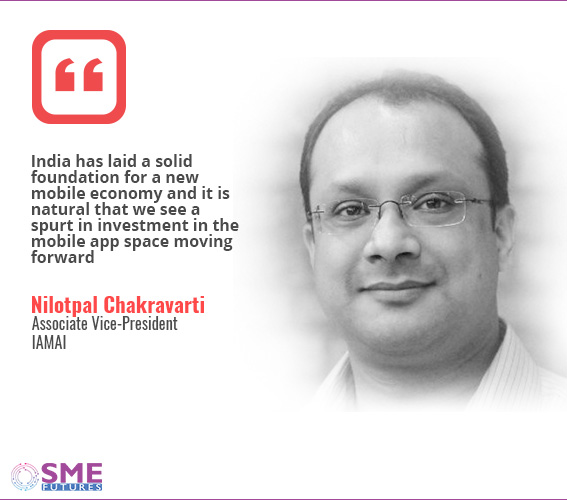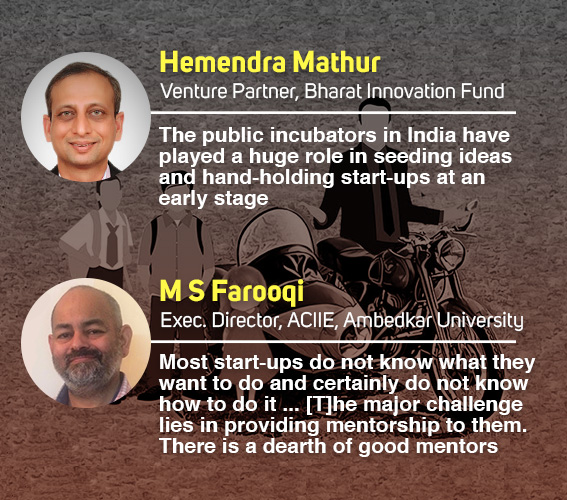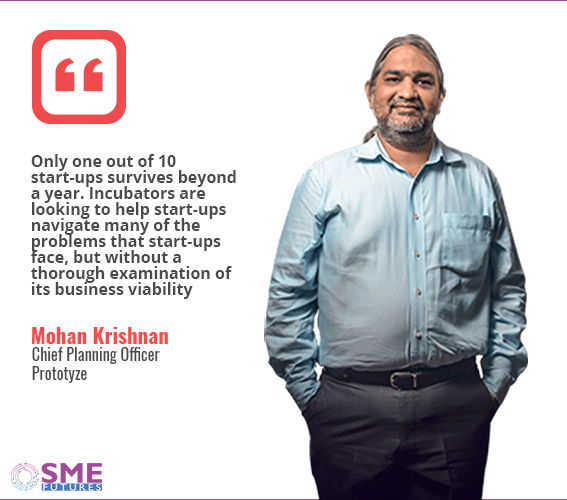It is not without reason that celebrity-turned-entrepreneur Gul Panag says: “Mobile start-ups, by their very nature, are an invigorating challenge. The inherent scalability, the pace of decision making and the intensity of working with smart, dynamic and talented individuals are an experience unlike any other.” Her three-year-old mobile fitness start-up, Mobiefit, has been registering a strong presence in the market. And, yes, she believes a lot of this environment has evolved only recently.
For the last 10 years, mobile start-ups have proliferated a lot in India. Just by its reach – of over 300+ million users – mobile phones have already established themselves as most preferred when it comes to accessing internet in India. Also, app usage has grown dramatically since September 2016 when Jio introduced subsidised, unlimited 4G access. And, according to the 2017 edition of a NASSCOM report, Indian Start-up Ecosystem-Traversing the Maturity Cycle, with approximately 5,000-5,200 tech start-ups in India, the growth in numbers of these technology ventures is up by 7 per cent year-on-year as of 2017. The report also suggests an impressive growth in the number of new-age advanced technology start-ups over the last two years registering approximately 700+ unique advanced tech start-ups.

India is a mobile first country, says, Nilotpal Chakravarti, Associate Vice President, Internet & Mobile Association of India (IAMAI). He says, according to the IAMAI-IMRB estimates, the total number of mobile internet users increased by 17.22 per cent from December 2016 to reach 456 million users by December 2017. Urban India witnessed an estimated 18.64 per cent year-on-year rise, while rural India witnessed an estimated growth of 15.03 per cent growth during the same period. In other words, India has laid a solid foundation for a new mobile economy and it is natural that we see a huge spurt in investment in the mobile app space.
Not only more Indians, as a recent Goldman Sachs report says, are getting on the internet bandwagon over the next 15 years than any other country, including China, India also ranks first in monthly average number of apps installed and used (40+), according to a report, State of App Marketing In India, released in March by AppsFlyer, a SaaS mobile marketing analytics and attribution platform. It seems this year India has surpassed the United States of America to become the number one country in the world in the number of non-organic installs. The app boom in India is quickly translating into significant growth of mobile advertisement budgets, according to the report. “Mobile is shooting upwards with the tipping point predicted to take place this year, when mobile will exceed desktop by nearly 3 per cent to eclipse $800 million in total spend,” states the report.
Talking about the domain trends and how the particular technology of mobile driven vertical has unfolded over the years, Prateek Saxena, Co-founder and Director, Appinventiv Technologies, a mobile app developer says: “Initially, a lot of innovators ventured into creating interesting games and restructured the entire gaming industry. For the last two to three years there has been a strong focus on utilising mobiles to provide solutions in health care sectors. Thus, health care industry has also evolved a lot. Blockchain, Internet of Things (IoTs) and artificial intelligence are presently shaping the mobile revolution in the continuum. With all these, the domain is ever-changing and will continuously keep evolving over time.”
The most dynamic industry
Who would ever forget the outstanding success of the outshining leader of the clan, Google Map, that had, in fact, 10 years ago made navigation so easy and had revolutionised the way we travel, simply with a mobile app. Besides, Indian banking industry too has marked sweeping fundamental changes, switching from habitual banking to handy banking. After ICICI Bank had launched its first iMobile services in India, almost all the banks have ensured their presence in the digital space.
India today is at the cusp of mobile and internet usage revolution, thanks to the large developers’ talent pool and increasing smartphone usage.
Says Panag of Mobiefit, which incidentally is an incubatee in Prototyze, a venture studio in Goa: “Smartphone penetration in India is tipped to grow at 18 per cent year-on-year and coupled with competitive data prices the opportunity is huge. Our solution (DIY Fitness Program) and the substantially lower price point vis-a-vis traditional avenues of fitness like gyms and personal trainers, will help us reach a much larger user base.”

She also point out how the cost of technology is coming down rapidly, and how the focus is now shifting to automation and more interactive experiences. “We are also looking at incorporating these trends with a new kind of voice-operated platform. Plus, with initiatives such as Startup India and Make in India, as well as the various state-level start-up policies, we expect to see many more entrepreneurs emerging from smaller towns and cities, building indigenous solutions for local problems,” adds Panag.
For Hemendra Mathur, Venture Partner, Bharat Innovation Fund, increasing mobile phone usage has been a huge catalyst for the growth registered in various verticals. “Many businesses in India have scaled up in last 10 years because of higher penetration of smartphones and improving data availability. Most e-com and payment gateways could not have scaled without mobile as a medium to reach end customers. Also, access to data for more than a billion owners of mobile is improving even in remote areas, which could be a game changer for many start-ups,” says Mathur.
Adding further to the growth of mobile and mobile driven industry’s presence in India is the fact that among global regions, Asia-Pacific (APAC) is leading the way to digitisation. In Asia, 19 per cent of manufacturers that were surveyed for Global Digital Operations Study 2018 Digital Champions, have achieved digital champion status, compared with 11 per cent in the Americas and 5 per cent in Europe, the Middle East, and Africa (EMEA). Asia-Pacific companies expect 17 per cent growth in digital revenue over the next five years, compared with the 13 per cent growth anticipated by EMEA companies. And that gap will likely continue to widen, as 32 per cent of Asian companies plan to have established mature digital ecosystems in the next five years, compared with 15 per cent in EMEA and 24 per cent in the Americas.
Many investors are also of the belief that investments in tech start-ups ensure much higher return on investment. Says Paul Basil, founder and CEO of Villigro Innovation Foundation: “When an investor invests his money, he needs to achieve exits. And to achieve exit, scale becomes important. For the tech start-ups and mobile based apps, the possibility and ability to scale is very high.”
“If you invest in creating a platform,” he continues, “lot of money goes in to it. Therein acquisition of each customer is incremental cost. Once you build solidly the tech platform, you can then keep on scaling it rapidly. Whereas, unlike the IT or e-commerce platform or a mobile app, building a certain physical product, say a water pump, involves development cycle, marketing cycle and what not. The acquisition of customers takes time, the distribution of the product takes time. As an investor, one would rather like to invest in something that would scale-up quickly. The post Flipkart era has seen so many of that model. Investors’ comfort and understanding of this particular space and the fact that the scale is far easier to achieve in this vertical is why investors are more inclined and excited towards mobile and tech start-ups,” adds Basil.
Scaling remains the key factor for Mathur of Bharat Innovation Fund as well. “Specialisation of tech and mobile domain is key for investors to screen and invest in quality deals. This kind of specialisation also comes handy for entrepreneurs in scaling their businesses as investors can not only validate their ideas quickly but also can connect them with the relevant ecosystem players.”
Why then start-ups fail?
Typically, weak business models, lack of cash flow, market knowledge and demand result in winding up of business. This is especially true for start-ups that are less than two years old. According to the 2017 NASSCOM report, although, B2B failure rates remain low, a major 80 per cent of B2C start-up base in India failed in 2017; it was 64 per cent in 2016. A major finding of the report also suggests that by registering more than 40 per cent failures in , Delhi NCR has come out as a top state for B2C start-up failures in India whereas Bengaluru leads with regard to B2B start-up failures with 33 per cent of the start-ups failing between 2012 and 2017.
Says Basil of Villigro Innovation Foundation: “Entrepreneurs think there is a market but there isn’t. They believe there is demand, but there actually is no demand. This is because of the lack of customer centric design at the product development phase. It is more passion driven and not customer driven. It is not the question of working capital management issue alone, but the right kind of fund for the company at the right time. The question is am I going to an institutional investor when an angel investor is required, or am I approaching a VC when bank should be funding. This disconnect to proper cash flow management leads to running out of cash.”
According to Mathur of Bharath Innovation Fund, the start-ups have to figure out backend and supply chain linkages to make a business out of it. “Developing mobile app alone is not the answer. Only app-based models have high mortality rates. Failure is inevitable.”
For Mohan Krishnan, Chief Planning Officer, Prototyze, a venture studio in Goa, the help that start-ups are getting initially from their backers should extend beyond financial and are crucial for their survival. “The Kaufmann Institute reports that only 1 out of 10 start-ups survive beyond a year. Incubators are looking to help startups navigate many of the problems that startups typically face, but without a thorough examination of its business viability,” says Krishnan. He goes on to explain how his venture studio is doing things different. “Venture studios are far more deeply involved with start-ups in trying to find answers to these problems, and we think that this helps the startup sharpen and validate their reason to exist far faster than would be otherwise. In our case, so far, all our start-ups have survived beyond a three-year period as well. The reason is that as a venture studio we help in the critical aspect after funding: which is handholding and coaching a venture through its journey. Accelerators and incubators focus on this for a very short duration (6-12 weeks). Whereas, we, as a venture studio, are there with the venture through its journey. This enables us to ensure higher success for the start-ups.”
Panang of Mobiefit feels lack of a well-defined market is the underlying cause for most failed start-ups, followed by flawed business modelling, and hyper-competitiveness. “Any start-up, regardless of the environment it is born in, faces some key challenges: Ensuring product market fit (PMF) at the earliest, getting users to pay, achieving unit economics, and scaling up of the business.”
The trick, according to her, is in working closely with the investors. “Unlike with traditional incubators, we work very closely with the Prototyze to jointly develop the venture blueprints, go-to-market strategy and plan the milestones of the venture journey,” she adds.
Retention is a significant pain
Also, the app space has become insanely competitive in recent years. The choice is all but endless and as a result users jump from one app to the next in no time. Retaining consumers long term is therefore a daunting task.
According to the AppsFlyer report, State of App Marketing In India, “After installing an app, only a handful of non-organic users in India remain active in that app. Three months in, across an entire week, the rate is just over 5 per cent. The challenge with low retention rates is that it is the basis of monetisation. Retention can be significantly improved by diving deep into the data with retention reports, cohort analysis and granular in-app measurement for optimised re-engagement campaigns.”
Also, the average storage space of a smartphone in India is significantly lower than other markets, particularly western ones, according to market research firm Counterpoint Research. This fact forces Indian users to delete apps at a much higher rate to free up space on their phones.
Over coming failures
Research is basically where we are missing feels Saxena of Appinventiv. “India is in dire need to focus on research. More time, space and money have to be allocated for research. Start-ups also need to concentrate on testing of products and test them with live audience. Government has to work on building labs and launching beta space, whereas, founders need to channelise their energy,” says Saxena.
However, according to Basil of Villigro Innovation Foundation, there is no need for government to subsidise entrepreneurs to make them grow; it should, at best, create enablers that drive entrepreneurship. For instance, according to him a policy that states “at least 20 per cent of procurement of PSUs will happen from start-ups,” is a good enabler. For this will create more demand in the ecosystem thereby solving one of the major problems triggering failures. “Such kind of intervention is a powerful intervention,” says Basil.

He also advocates moves like making entrepreneurship a subject and, to make it a more attractive choice, a grant of 20 per cent attendance can be given to students who choose entrepreneurship as a subject to specialise in. In other words, although India has a strong mobile phone penetration and an increasingly cheaper access to internet, these do not automatically validate success stories. Sustaining a venture takes a lot of effort and an entrepreneur should be supported in every possible way.













